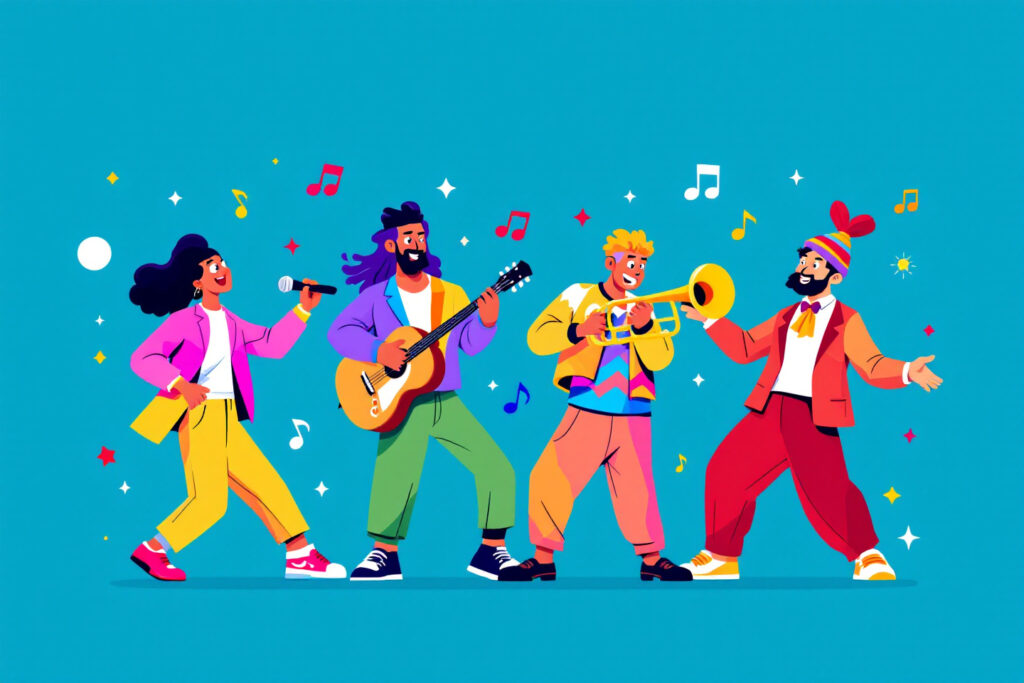
Learning music vocabulary is important and useful in life for several reasons:
– improves language skills
– enhances social interaction and connections
– cultural understanding and appreciation
– enhances communication skills
– boosts cognitive skills, such as memory and creativity.
– opens up opportunities in various fields
– emotional and personal growth
This lesson will help you achieve all of this!
Music Terms
General Music Terms
Music – The art of combining sounds to create melody, rhythm, and harmony.
Song – A short piece of music with lyrics.
Instrument – A tool used to create music, such as a piano, guitar, or drum.
Melody – A sequence of musical notes that is pleasing to the ear.
Rhythm – The pattern of beats or time in music.
Harmony – The combination of different musical notes played at the same time.
Pitch – The highness or lowness of a musical note.
Tempo – The speed of the music (fast, slow, moderate).
Lyrics – The words of a song.
Composer – A person who writes music.
Conductor – A person who directs a musical performance, especially an orchestra.
Music Performance

Concert – A live performance of music.
Gig – A small performance, often used for casual events.
Rehearsal – A practice session before a performance.
Solo – A performance by a single musician.
Encore – An additional performance after the main concert, often in response to audience applause.
Music Production
Track – A single song or recording.
Album – A collection of songs or music tracks, usually by the same artist or group.
Studio – A place where music is recorded.
Producer – A person who oversees the recording and production of music.
Recording – The process of capturing music or sound on a medium like tape, digital files, or vinyl.

Music Genres
Music genres are categories that define the style, structure, and cultural background of music.

Here are some of the most popular music genres, each with its own characteristics:
1. Pop
- Characteristics: Catchy melodies, simple lyrics, and a repetitive structure.
- Instruments: Electronic beats, synthesizers, guitar, drums.
- Artists: Taylor Swift, Ed Sheeran, Ariana Grande.
2. Rock
- Characteristics: Strong rhythms, electric guitars, and a rebellious attitude.
- Subgenres: Classic rock, punk rock, alternative rock, hard rock.
- Artists: The Beatles, Led Zeppelin, Foo Fighters.
3. Hip-Hop
- Characteristics: Rhythmic speech (rapping), strong beats, and often socially aware lyrics.
- Instruments: Turntables, drum machines, and samplers.
- Artists: Tupac, Drake, Kendrick Lamar.
4. Classical
- Characteristics: Complex compositions, orchestral arrangements, and formal structure.
- Instruments: Violin, piano, flute, cello.
- Composers: Beethoven, Mozart, Bach.
5. Jazz
- Characteristics: Improvisation, complex harmonies, and swing rhythm.
- Instruments: Saxophone, trumpet, piano, double bass.
- Artists: Miles Davis, John Coltrane, Louis Armstrong.
6. Blues
- Characteristics: Emotional depth, repetitive chord progressions, and a “call-and-response” format.
- Instruments: Guitar, harmonica, bass, drums.
- Artists: B.B. King, Muddy Waters, Robert Johnson.
7. Country
- Characteristics: Storytelling lyrics, acoustic instruments, and often focuses on life, love, and rural themes.
- Instruments: Acoustic guitar, banjo, fiddle.
- Artists: Johnny Cash, Dolly Parton, Garth Brooks.
8. Electronic Dance Music (EDM)
- Characteristics: Synthesized beats, repetitive melodies, and heavy bass.
- Subgenres: House, techno, dubstep.
- Artists: Calvin Harris, Deadmau5, Avicii.
9. Reggae
- Characteristics: Offbeat rhythms, relaxed tempo, and socially conscious lyrics.
- Instruments: Bass guitar, drums, keyboard.
- Artists: Bob Marley, Peter Tosh, Toots and the Maytals.
10. R&B (Rhythm and Blues)
- Characteristics: Smooth melodies, strong beats, and emotional vocals, often focusing on love and relationships.
- Instruments: Piano, drums, synthesizers.
- Artists: Beyoncé, Usher, Alicia Keys.
11. Metal
- Characteristics: Loud, aggressive sound, heavy guitar riffs, and intense vocals.
- Subgenres: Heavy metal, death metal, thrash metal.
- Artists: Metallica, Iron Maiden, Slayer.
12. Folk
- Characteristics: Traditional storytelling, acoustic instruments, and often deals with cultural or political themes.
- Instruments: Acoustic guitar, banjo, harmonica.
- Artists: Bob Dylan, Joan Baez, Woody Guthrie.
13. Latin
- Characteristics: Rhythmic beats, Spanish or Portuguese lyrics, and danceable melodies.
- Subgenres: Salsa, merengue, reggaeton.
- Artists: Shakira, Daddy Yankee, Marc Anthony.
14. Soul
- Characteristics: Emotional expression, powerful vocals, and gospel influences.
- Instruments: Bass, guitar, piano, drums.
- Artists: Aretha Franklin, Marvin Gaye, Otis Redding.
15. Reggaeton
- Characteristics: A fusion of Latin, Caribbean, and hip-hop, characterized by repetitive beats and rhythmic flow.
- Instruments: Synthesizers, drum machines, and sampled sounds.
- Artists: J Balvin, Bad Bunny, Daddy Yankee.
16. Punk
- Characteristics: Fast-paced, aggressive music, often with political or anti-establishment lyrics.
- Instruments: Electric guitar, bass, drums.
- Artists: The Ramones, The Clash, Green Day.
17. Gospel
- Characteristics: Religious lyrics, uplifting melodies, and strong vocals.
- Instruments: Organ, piano, choir.
- Artists: Kirk Franklin, Mahalia Jackson, Andraé Crouch.
18. Indie
- Characteristics: Independent production, experimental sound, and creative freedom.
- Subgenres: Indie rock, indie pop.
- Artists: Arctic Monkeys, Bon Iver, The 1975.
Learning Activities
Activity #1: Genre Quiz! Teacher will play about 10 to 15 secs of a song and on a piece of paper you have to write what genre you think it is.
Activity #2: Genre Charades! One student will go to the front of the class and with their hands and body, they have to act out 1 genre (somehow!) the rest of the students will take turns guessing.
Activity #3: Divide the class in groups. Each group has to make a song! First choose the genre and then the lyrics. Students have to get creative to create the beat, medoly, harmony, etc.
